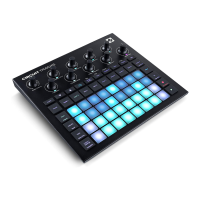38 39
Recording from an external controller
You can also create a synth pattern in Circuit Tracks by sending it MIDI note data from an external
controller. This gives you the ability to play Circuit Tracks’ synth patches from a standard music
keyboard. The default settings are: MIDI note data Receive is ON; Synth 1 uses MIDI Channel 1 and
Synth 2 uses MIDI Channel 2. These settings may be changed in Setup View, see page 104 for full
information on setting up how Circuit Tracks sends and receives MIDI data generally.
Note that the selected Scale and Root Note still takes effect when Circuit Tracks receives MIDI note data.
If a note which does not occur in the currently selected Scale is played on an external
controller, Circuit Tracks will ‘snap’ to the nearest note in the current Scale. Any possible
“wrong notes” resulting from this can be avoided by selecting Chromatic Scale: this will
ensure that all notes on a normal keyboard will be available.
Step editing
Step editing operations in Circuit Tracks may either be done with the Pattern running (i.e., in Play
mode) or not running (i.e., in Stop mode).
All the following details apply equally – and independently - to Synth 1 and Synth 2; use the Synth 1
or Synth 2 buttons to see the individual contributions of the two tracks to the overall Pattern.
In Note View (note – not Expanded Note View), the two upper rows of grid pads is the 16-step pattern
display and the two lower rows constitute the synth keyboard. When a pattern is played, you can
see the white pad moving through the 16 steps. Where a step has a note present, the keyboard pad
corresponding to the note being played illuminates white while the note is sounding (but see below
regarding octaves).
In Stop mode, you can listen to the notes assigned to each step and alter the pattern manually. In Play
mode, you will only hear the notes associated with each step when the sequence reaches the step.
(But if you mute the synth track in Mixer View while the sequence is playing, you can press any of the
illuminated pattern step pads to hear the note(s) assigned to a step .)
The pads for the steps which have notes associated with them will be illuminated bright blue. One
step pad will flash white/blue: this shows where the pattern had reached when it was stopped. This is
shown in the first diagram below. However, note that when you press Play again, the pattern will
restart from Step 1: however, this may be overridden by holding down Shift while pressing Play; in
this case the pattern will continue from the step at which it was stopped.

